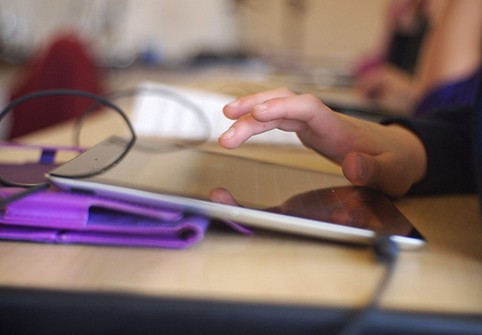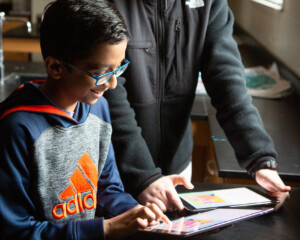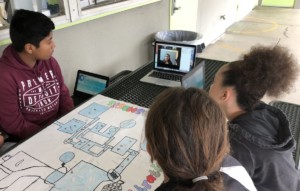Branding & EdTech: On the Road from Funding to Credibility

Building a brand can feel like a BIG undertaking, especially in the fast growing industry of EdTech. By 2017, the worldwide market for mobile learning products and services alone is expected to be worth $12.2B. Setting yourself apart from competition is one thing, making sure your audience understands and values those differences is another. Intentional brand development is essential.
Seem daunting? Doesn’t have to be. As a learning design firm, Getting Smart Services provides strategic marketing support for companies and organizations looking to expand reach and amplify impact.
That’s why we were so excited when Brandon Walsh, Principal and Director of Digital Strategy with Sametz Blackstone Associates shared his blog on mosaicbranding.com that explores the unique branding opportunity for EdTech companies.
Brandon Walsh
Right now, few industries are experiencing change quite like education technology. It’s a bumpy ride, but branding can help.
LearnLaunch‘s recent Across Boundaries conference brought together 500 entrepreneurs, educators, investors, students, and other industry experts to discuss critical barriers to EdTech success. There are many, including regulations and policy; an aversion to technology among some critical stakeholders; legacy, non-convergent platforms; data, copyright, and privacy issues; and of course, cash-strapped schools.
At the same time, however, I heard a lot about immediate challenges that are more easily solved. Speakers and attendees talked at length about the importance of credibility, alleviating risk, engaging a range of stakeholders, creating a greater sense of value, and, of course, promulgating stories. In other words, while much of the talk was about students, teachers, curriculum, apps, and iPads, branding was very much in the air.
Why? Because branding isn’t window-dressing. Quite the opposite. Well-planned and thoughtfully implemented, branding solves real-world problems and helps businesses (including start-ups) navigate ever-changing landscapes.
Case in point
EdTech seed funding is flowing. More than $450 million in VC money flowed into K-12 eduction technology in 2013 (up 6% from 2012, and this doesn’t include higher-ed investment). More than half that money was for seed stage investments. In an industry where there will likely be no overnight game-changers—remember all those barriers?—seed funding is not only just the beginning, it’s only a part of the equation. Success in EdTech is a long-term game. And as one prominent entrepreneur noted during the very first panel of the conference, success will ultimately be about building and sustaining credibility.
Credibility—that same prominent entrepreneur noted—is brand.
And along the way…
Brand helps alleviate risk
It was stated during the conference that successful startups in the EdTech space must help reduce perceptions of risk. Potential investors, customers, and partners will all experience a sense of risk in one dimension or another as they engage with you. And engagement isn’t a single point, it’s a continuum. Are you able to articulate the different points of the customer journey for your product? Do you have the brand-building messages (and means) to interact with constituents at those key points? If not, good luck converting skeptical faculty, gun-shy CIOs, and budget-strapped administrators. A thoughtful approach to branding—reinforced with the right informational cues (both verbal and visual), at the right moments—will help ease feelings of risk during critical moments of engagement.
Moreover, investing in brand enables start-ups to reinforce the themes they want to be known for and help mitigate against those they don’t, insulating them against certain threats, and helping conversations with prospects start at square one (or two!) instead of square zero (or the wrong square altogether).
Brand allows for different ways in
It’s abundantly clear from Across Boundaries that educators have a different view than administrators, investors have a different perspective than partners, students have their own view, and so on. Meanwhile, cutting across all of these perspectives, some individuals are more in tune with emotional / aspirational language, while others want straight facts and only facts. The point: your audience is not monolithic, and successful start-up brands will be those that enable different “ways in” to their story—depending on the vantage point of those they’re seeking to engage. Doing so, on a tactical level, requires a visual and verbal communication system with different tiers, tilts, and channels. Websites, in particular, must be permeable in different ways to engage users with different interests and information needs. Yet every point must still support the same big-picture brand story. Here at Sametz Blackstone, we call this Mosaic Branding.
Brand exudes value above and beyond product
We’ve all heard the “drill / hole” analogy (customers ultimately buy holes, not drill bits). The same is true in the EdTech space. One panelist implored EdTech entrepreneurs to ask themselves, “What’s the biggest education problem you can help solve?” They went on to note how framing your start-up around that question is a much longer-term, brand-building approach than working towards the most lucrative set of application specs a particular VC might be interested in. In other words, it’s about elevating your value from what, to so what, and building a mission-driven brand. Mission-driven brands give people a reason to engage that’s deeper and longer-lived than any one product. For EdTech start-ups, forging a deeper connection can add value, increase differentiation, and move products away from being evaluated as commodities. (“Mission” isn’t just for nonprofits!)
Brand supports storytelling
There is perhaps no more powerful currency in the EdTech space than a good story. Whether an inspirational impact story or a matter-of-fact revenue story, entrepreneurs at Across Boundaries spoke often about the importance of storytelling in transmitting successes in a compelling manner. Why? Because success begets success, and good stories help us understand the complex, shape our beliefs, and enable us to move forward. Stories are easy to share, they stick, and they accrue value (and credibility!) to your brand—and, equally importantly, vice versa. In EdTech, however, with its emphasis on technology, it seems there are many more gifted programmers than storytellers. In the journey from what, to so what, EdTech startups ought to hone their storytelling chops as a way to build brand. Here are a few tips.
Prepare for the long haul
Again, EdTech is going to be a long-term game. Meaningful innovation will not happen overnight. Given all the players involved—some of whom are skeptics and / or technology averse—success is going to be directly related to your ability to build credibility over time, and to navigate the wildly bumpy EdTech landscape. You’ll need plenty of funding, and a great product. In order to nurture and sustain the relationships needed to really move the needle on student success (at scale), you’ll need a means to frame your value above and beyond product, to insulate yourself from risk and negative perceptions, and to meet people where they’re coming from with differentiating messages, stories, and visuals that matter to them.
Technology and funding will likely provide the spark, but brand is the vessel that will ultimately carry EdTech start-ups to credibility and success.
Invest wisely… it’s a bumpy road.
For more check out:
- Blogging is Alive and Well for Leaders, Learners and Lead Generators
- Build Your Brand: How a Positive Social Media Presence can Lead to a Career
- DIY: Sweat Equity Brand Building
Brandon C. Walsh, Principal and Director of Digital Strategy at Sametz Blackstone Associates and advisor on branding matters to Listen Current. Follow Brandon on Twitter, @Calmstock.
Courtesy of Brad Flickinger, Flickr







0 Comments
Leave a Comment
Your email address will not be published. All fields are required.